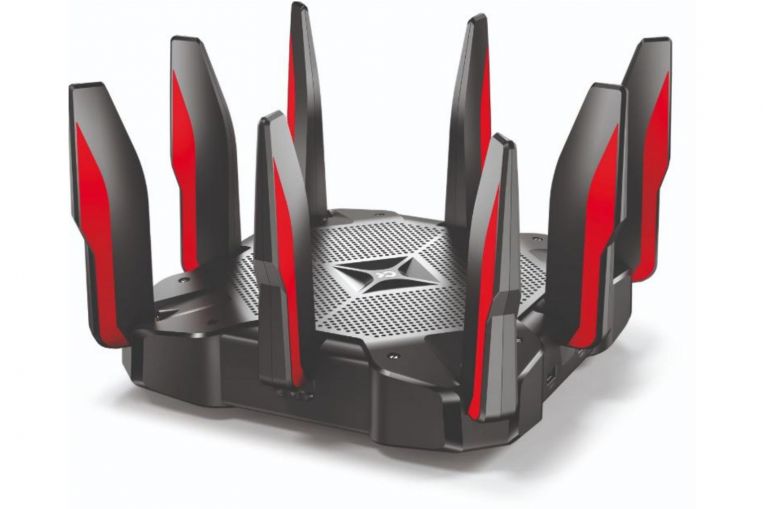TP-Link’s new Archer AX11000 router goes after the gaming crowd with a flashy design backed by support for the latest Wi-Fi 6 standard.
Also known as 802.11ax, Wi-Fi 6 promises faster wireless performance than its predecessor, though the caveat is that only a compatible Wi-Fi 6 client will experience any speed boost.
While Wi-Fi 6 routers have been around for about a year, client device are only now making their way into the market in significant numbers. Many of the laptops launched late last year and upcoming smartphones this year, for instance, are compatible with Wi-Fi 6.
TP-Link seems to have modelled the look and feel of its Archer AX11000 router in the vein of PC gaming products. It is drenched in red and black colours, from chassis to app and browser interfaces.
Its exterior has a meshed, well-ventilated design. At the base of the router are four holes to mount it on a wall. Like many high-end routers, it weighs over a kilogram.
Its eight external antennas point up and cannot be adjusted. There are eight Gigabit LAN ports, as well as a WAN port that supports speeds of up to 2.5Gbps. It also has a USB Type-A port and a USB Type-C port that can be used to connect to devices such as an external hard drive or a printer.
TP-Link’s Tether mobile app (available for iOS and Android) can be used to set up the router and configure its settings via a smartphone. The app is adequate for simple tasks such as turning on guest Wi-Fi networks and checking the list of connected clients in real time.
But for more advanced settings such as port forwarding and VPN server, you have to log into the router’s Web-based interface. For added security, only one user can be logged in to the app or the Web interface at the same time.
The app also lets you access TP-Link’s HomeCare suite of networking features that are included with the router. These features, powered by Trend Micro, help to protect users from malware, block and filter Internet access and manage the Quality of Service (QoS) to selected clients. They come with basic options that are understandable to even novices. For instance, you simply choose from one of several presets such as Gaming or Streaming for the QoS feature.
My usual router speed test involves two notebooks – one connected to the router via Ethernet cable while the other is connected wirelessly. I would then measure the download speed between the two laptops.
Since the key metric here is the router’s Wi-Fi 6 performance, I substituted my usual laptop, which uses the older Wi-Fi 5 standard (802.11ac) with the HP Elite Dragonfly laptop, which has an Intel Wi-Fi 6 chipset. The HP notebook was placed in the same living room as the router, about 5 metres away from the router.
In my test, the average download speed using Wi-Fi 6 was 830Mbps. This dropped to 602Mbps when tested with a Wi-Fi 5-compatible notebook instead.
In short, compatible clients using a Wi-Fi 6 network will experience a definite increase in wireless speed. And I am not even going into the other benefits of the new wireless technology, such as the ability to support more devices concurrently and lower power consumption for client devices.
However, it must also be noted that the 5GHz wireless bands used by Wi-Fi 6 are similarly affected by obstacles such as thick walls and doors. When I placed the Wi-Fi 6 notebook in a distant bedroom with the door closed, its speed dropped to around 110Mbps, which is similar to that of a laptop using the Wi-Fi 5 standard.
Overall, the Archer AX11000 offers plenty of features and is relatively easy to use. And even if you do not yet have any Wi-Fi 6 client devices, it could be worth a look for the future.
FOR
Plenty of LAN and USB ports
Excellent wireless performance, especially with Wi-Fi 6 clients
Mobile app offers ease of use
AGAINST
Bulky chassis
Pricey
SPECS
Price: $609
Ethernet Interface: 2.5Gbps WAN port, 8 x Gigabit LAN ports
Standards: 802.11a/b/g/n/ac/ax
Security: 64/128-bit WEP, WPA/WPA2, WPA-PSK/WPA2-PSK
Advanced Firewall Features: NAT and SPI
RATING
Features: 4.5/5
Design: 4/5
Performance: 5/5
Value for money: 3.5/5
Overall: 4/5
Source: Read Full Article
